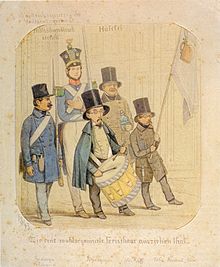Free troop trains

The free troop moves were two failed anti-clerical overthrow attempts in Switzerland in 1844 and 1845 . The aim of the radical-liberal insurgents was to overthrow the conservative government of the canton of Lucerne and to drive out the Jesuits . Other cantons were with the posting of irregulars indirectly involved, while the Diet was holding back. The uprisings resulted in the foundation of the Sonderbund and triggered the Sonderbund War .
First free movement
The indirect trigger for the free marches was the abolition of the monasteries in the canton of Aargau in January 1841 ( Aargauer Klosterstreit ). Thereupon, on August 19, 1844, the canton of Aargau applied to the daily statute to expel the Jesuits from Switzerland, but this was rejected. The canton of Lucerne, ruled by Catholic Conservatives, called the Jesuits to higher education on October 24, which caused outrage in liberal circles.
In a poorly coordinated attempt to overthrow, around 100 liberal-minded Lucerne people gathered on December 8, 1844, but were driven apart by government troops. At the same time, around 1000 irregulars from the cantons of Aargau, Solothurn and Baselland moved towards Lucerne . The militants were able to fight back the Lucerne government troops near Emmenbrücke , but they were divided on how to proceed and had to withdraw, as strong Lucerne militia groups had moved in in the meantime. The Lucerne government took action against the insurgents with numerous arrests and political and economic repression, but many bystanders were also affected.
Second free movement
As a reaction to the suppression of the first uprising, a mass movement against the Lucerne government formed in the liberal cantons. The agitation on the liberal side reached a new high point, spurred on by refugees from Lucerne. Anti-Jesuit associations were formed, popular assemblies were held, petitions were organized, and inflammatory articles appeared in the newspapers. Various cantons officially opposed a possible second free movement, but secretly pledged support.
Led by the later Federal Councilor Ulrich Ochsenbein and the deposed Lucerne Councilor Jakob Robert Steiger , around 3,500 volunteers from Huttwil and Zofingen moved in the direction of Lucerne on the night of March 30th to 31st, 1845 . Prominent participants were also the future Federal President Jakob Dubs and the poet Gottfried Keller , but they did not take part in any fights. With a forced march, the main force of the rebels advanced until shortly before Lucerne. Because of the falling darkness and the general exhaustion of the already severely decimated troops, Ochsenbein decided not to bombard and capture the city.
A shot accidentally fired during the night led to a panic-like escape among the disordered and insecure rioters. Larger divisions got ambushed at Malters (see battle at Malters ). The next morning, the Lucerne government troops only encountered smaller groups. Overall, the fighting claimed over 120 deaths, including more than 100 among the irregulars. The Lucerne people made around 2000 prisoners. The cantonal government cracked down on the insurgents: over 700 people from Lucerne were sentenced to prison terms, and the irregulars from other cantons were released in exchange for high ransom payments. These events found literary expression in Gottfried Keller's short story " Frau Regel Amrain und Ihr Jüngster ", published in 1856 in the collection of short stories The People of Seldwyla .
The seven Catholic cantons of Lucerne, Uri , Schwyz , Unterwalden , Zug , Friborg and Valais formed the Sonderbund as a reaction to the two free marches . After its existence became known a year later, the fronts hardened further, and the conflict that had been fueled for years erupted in the 1847 Sonderbund War .
literature
- Otto Gass: The political prehistory to the free march against Lucerne in 1844. In: Basler Zeitschrift für Geschichte und Altertumskunde , Vol. 20, 1922, pp. 204-312. ( e-periodica.ch )
- JMRudolf and JJ Leuthy: The free march against Lucerne on March 31, 1st and 2nd April 2, 1845 and its next consequences. Zurich 1846. googlebooks
Web links
- Kurt Münger: Free troops. In: Historical Lexicon of Switzerland .
